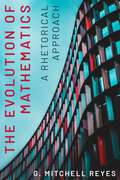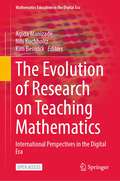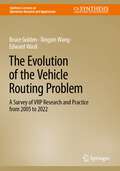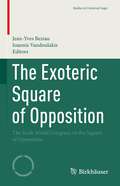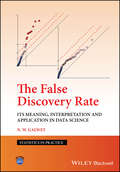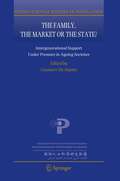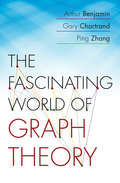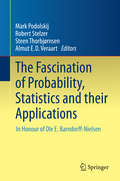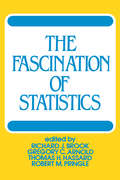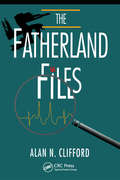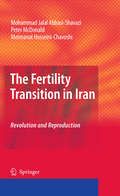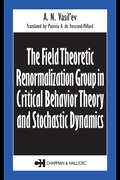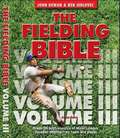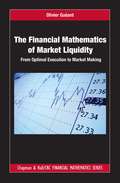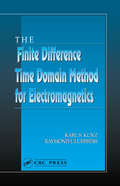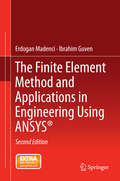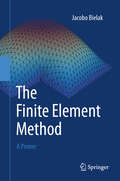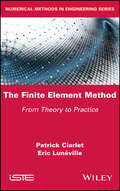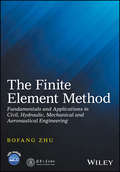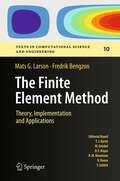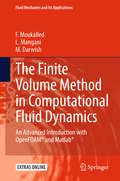- Table View
- List View
The Evolution of Mathematics: A Rhetorical Approach (RSA Series in Transdisciplinary Rhetoric)
by G. Mitchell ReyesThere is a growing awareness among researchers in the humanities and social sciences of the rhetorical force of mathematical discourse—whether in regard to gerrymandering, facial recognition technologies, or racial biases in algorithmic automation. This book proposes a novel way to engage with and understand mathematics via a theoretical framework that highlights how math transforms the social-material world.In this study, G. Mitchell Reyes applies contemporary rhetorical analysis to mathematical discourse, calling into question the commonly held view that math equals truth. Examining mathematics in historical context, Reyes traces its development from Plato’s teaching about abstract numbers to Euclidian geometry and the emergence of calculus and infinitesimals, imaginary numbers, and algorithms. This history reveals that mathematical innovation has always relied on rhetorical practices of making meaning, such as analogy, metaphor, and invention. Far from expressing truth hidden deep in reality, mathematics is dynamic and evolving, shaping reality and our experience of it.By bringing mathematics back down to the material-social world, Reyes makes it possible for scholars of the rhetoric and sociology of science, technology, and math to collaborate with mathematicians themselves in order to better understand our material world and public culture.
The Evolution of Research on Teaching Mathematics: International Perspectives in the Digital Era (Mathematics Education in the Digital Era #22)
by Nils Buchholtz Kim Beswick Agida ManizadeThis open access book investigates current issues related to the evolution of research on teaching mathematics and examines up to thirty years of presage-process-product research (PPPR) in mathematics with respect to conceptualization, instrumentation, and design. The book discusses the theoretical and methodological challenges associated with PPPR, critically reviews current research, and explores the likely direction of further developments to identify future paths for research on high-quality mathematics teaching in the digital era. Subjects that are covered in this work focus on the relationships between 1) student learning outcomes measured upon completion of the mathematics teaching; 2) student learning activities in the classroom; 3) interactive mathematics teacher activities, and best practices in mathematics classrooms conducted in the presence of students; 4) pre-post-active mathematics teacher activities such as planning, assessment, and other teaching-related activities outside of the classroom; 5) mathematics teachers’ competencies, knowledge, and skills; and 6) mathematics teachers’ characteristics, including beliefs, attitudes, and motivation. This book discusses the evolution of such research in mathematics teaching and teacher education in the digital era and is of interest to researchers exploring the field of mathematics teaching and mathematics teacher education as well as educators.
The Evolution of the Vehicle Routing Problem: A Survey of VRP Research and Practice from 2005 to 2022 (Synthesis Lectures on Operations Research and Applications)
by Bruce Golden Xingyin Wang Edward WasilThis book presents state-of-the-art research and practice in optimization routing, specifically the vehicle routing problem (VRP). Since its introduction in the late 1950s, the VRP has been a very significant area of research and practice in operations research. Vehicles are used to make deliveries and for pick-ups every day and everywhere. Companies such as Amazon, UPS, FedEx, and DHL use route optimization to reduce mileage, fuel use, number of trucks on the road, and carbon dioxide emissions. The authors compile and analyze 135 survey and review articles on vehicle routing topics published between 2005 and 2022 in an effort to make key observations about publication and trend history, summarize the overall contributions in the field, and identify trends in VRP research and practice. The authors have compiled published research on models, algorithms, and applications for specific areas, including: alternative and multiple objectives; arc routing and general routing; drones, last-mile delivery, and urban distribution; dynamic and stochastic routing; green routing; inventory routing; loading constraints; location-routing; multiple depots; pickup and delivery and dial-a-ride problems; rich and multi-attribute routing; routing over time; shipping; two-echelon, collaborative, and inter-terminal problems; specific variants, benchmark datasets, and software; and exact algorithms and heuristics. In addition, the book discusses how vehicle routing problems are among the most widely studied problems in combinatorial optimization due to the mathematical complexity and practical significance.
The Existence of the External World: The Pascal-Hume Principle
by Jean-Rene VernesAlthough thousands of works have been published on the philosophy of knowledge, philosophers have not yet managed to come to a consensus on the fundamental issue: is there a reality that exists outside of consciousness and, if so, how can we prove it? Apart from historical and critical writings, the essential works, those that contemporary thought can use as solid foundations to discover new truths, amount to a few hundred pages at most. We will discuss some of them.
The Exoteric Square of Opposition: The Sixth World Congress on the Square of Opposition (Studies in Universal Logic)
by Jean-Yves Beziau Ioannis VandoulakisThe theory of the square of opposition has been studied for over 2,000 years and has seen a resurgence in new theories and research since the second half of the twentieth century. This volume collects papers presented at the Sixth World Congress on the Square of Opposition, held in Crete in 2018, developing an interdisciplinary exploration of the theory. Chapter authors explore subjects such as Aristotle’s ontological square, logical oppositions in Avicenna’s hypothetical logic, and the power of the square of opposition to solve theological problems regarding predestination and theodicy. Other topics covered include:Hegel’s opposition to diagramsDe Morgan’s unpublished octagon of opposition turnstile figures of oppositioninstitutional model-theoretic treatment of oppositionsLacan’s four formulas of sexuationthe theory of oppositional poly-simplexesThe Exoteric Square of Opposition will appeal to pure logicians, historians of logic, semioticians, philosophers, theologians, mathematicians, and psychoanalysts.
The Failure of Risk Management
by Hubbard Douglas W.An essential guide to the calibrated risk analysis approach The Failure of Risk Management takes a close look at misused and misapplied basic analysis methods and shows how some of the most popular "risk management" methods are no better than astrology! Using examples from the 2008 credit crisis, natural disasters, outsourcing to China, engineering disasters, and more, Hubbard reveals critical flaws in risk management methods-and shows how all of these problems can be fixed. The solutions involve combinations of scientifically proven and frequently used methods from nuclear power, exploratory oil, and other areas of business and government. Finally, Hubbard explains how new forms of collaboration across all industries and government can improve risk management in every field. Douglas W. Hubbard (Glen Ellyn, IL) is the inventor of Applied Information Economics (AIE) and the author of Wiley's How to Measure Anything: Finding the Value of Intangibles in Business (978-0-470-11012-6), the #1 bestseller in business math on Amazon. He has applied innovative risk assessment and risk management methods in government and corporations since 1994. "Doug Hubbard, a recognized expert among experts in the field of risk management, covers the entire spectrum of risk management in this invaluable guide. There are specific value-added take aways in each chapter that are sure to enrich all readers including IT, business management, students, and academics alike" -Peter Julian, former chief-information officer of the New York Metro Transit Authority. President of Alliance Group consulting "In his trademark style, Doug asks the tough questions on risk management. A must-read not only for analysts, but also for the executive who is making critical business decisions. " -Jim Franklin, VP Enterprise Performance Management and General Manager, Crystal Ball Global Business Unit, Oracle Corporation.
The False Discovery Rate: Its Meaning, Interpretation and Application in Data Science (Statistics in Practice)
by N. W. GalweyThe False Discovery Rate An essential tool for statisticians and data scientists seeking to interpret the vast troves of data that increasingly power our world First developed in the 1990s, the False Discovery Rate (FDR) is a way of describing the rate at which null hypothesis testing produces errors. It has since become an essential tool for interpreting large datasets. In recent years, as datasets have become ever larger, and as the importance of ‘big data’ to scientific research has grown, the significance of the FDR has grown correspondingly. The False Discovery Rate provides an analysis of the FDR’s value as a tool, including why it should generally be preferred to the Bonferroni correction and other methods by which multiplicity can be accounted for. It offers a systematic overview of the FDR, its core claims, and its applications. Readers of The False Discovery Rate will also find: Case studies throughout, rooted in real and simulated data sets Detailed discussion of topics including representation of the FDR on a Q–Q plot, consequences of non-monotonicity, and many more Wide-ranging analysis suited for a broad readership The False Discovery Rate is ideal for Statistics and Data Science courses, and short courses associated with conferences. It is also useful as supplementary reading in courses in other disciplines that require the statistical interpretation of ‘big data’. The book will also be of great value to statisticians and researchers looking to learn more about the FDR. STATISTICS IN PRACTICE A series of practical books outlining the use of statistical techniques in a wide range of applications areas: HUMAN AND BIOLOGICAL SCIENCES EARTH AND ENVIRONMENTAL SCIENCES INDUSTRY, COMMERCE AND FINANCE
The Family, the Market or the State?
by Gustavo De SantisThis book touches upon a few of the major challenges that all modern societies will have to face in the near future: how to set up a resilient pay-as-you-go pension system; whether the current balance between expenses and revenues in social expenditure is viable in the future, and, if not, what changes need to be introduced; whether the relative well-being of the current and future cohorts of the old will be preserved, and how their standards of living compare to those experienced by the old in the recent past. At the micro level, the exchanges between generations are presented and discussed in detail: how they have evolved in the recent past in terms of time, money, co-residence and proximity, and what will likely happen next. The geographical scope is on the developed countries, plus South Korea. A rich documentation of tables and graphs supports the scientific analyses and the policy implications in each of the nine chapters of this book, where demography, sociology, and economics intersect fruitfully, both at the macro and at the micro level.
The Fascinating World of Graph Theory
by Arthur Benjamin Ping Zhang Gary ChartrandThe fascinating world of graph theory goes back several centuries and revolves around the study of graphs--mathematical structures showing relations between objects. With applications in biology, computer science, transportation science, and other areas, graph theory encompasses some of the most beautiful formulas in mathematics--and some of its most famous problems. For example, what is the shortest route for a traveling salesman seeking to visit a number of cities in one trip? What is the least number of colors needed to fill in any map so that neighboring regions are always colored differently? Requiring readers to have a math background only up to high school algebra, this book explores the questions and puzzles that have been studied, and often solved, through graph theory. In doing so, the book looks at graph theory's development and the vibrant individuals responsible for the field's growth.Introducing graph theory's fundamental concepts, the authors explore a diverse plethora of classic problems such as the Lights Out Puzzle, the Minimum Spanning Tree Problem, the Königsberg Bridge Problem, the Chinese Postman Problem, a Knight's Tour, and the Road Coloring Problem. They present every type of graph imaginable, such as bipartite graphs, Eulerian graphs, the Petersen graph, and trees. Each chapter contains math exercises and problems for readers to savor.An eye-opening journey into the world of graphs, this book offers exciting problem-solving possibilities for mathematics and beyond.
The Fascination of Probability, Statistics and their Applications
by Mark Podolskij Robert Stelzer Steen Thorbjørnsen Almut E. D. VeraartCollecting together twenty-three self-contained articles, this volume presents the current research of a number of renowned scientists in both probability theory and statistics as well as their various applications in economics, finance, the physics of wind-blown sand, queueing systems, risk assessment, turbulence and other areas. The contributions are dedicated to and inspired by the research of Ole E. Barndorff-Nielsen who, since the early 1960s, has been and continues to be a very active and influential researcher working on a wide range of important problems. The topics covered include, but are not limited to, econometrics, exponential families, Lévy processes and infinitely divisible distributions, limit theory, mathematical finance, random matrices, risk assessment, statistical inference for stochastic processes, stochastic analysis and optimal control, time series, and turbulence. The book will be of interest to researchers and graduate students in probability, statistics and their applications.
The Fascination of Statistics
by Richard J. BrookThis book demonstrates how numbers open up new ways of thinking about problems and addresses current issues for which statistics has practical applications. The articles are classified according to probability, condensing data, testing, estimation, experimental design, prediction, and modelling.
The Fatherland Files
by Alan CliffordIn this exciting novel, an unsuspecting cardiologist becomes embroiled in a plot involving pharmaceuticals, international espionage, and the Neo-Nazi movement. A scientifically accurate twist on the average mystery story, the plot will hook all audiences.
The Fertility Transition in Iran
by Meimanat Hosseini-Chavoshi Mohammad Jalal Abbasi-Shavazi Peter McdonaldConfounding all conventional wisdom, the fertility rate in the Islamic Republic of Iran fell from around 7.0 births per woman in the early 1980s to 1.9 births per woman in 2006. That this, the largest and fastest fall in fertility ever recorded, should have occurred in one of the world's few Islamic Republics demands explanation. This book, based upon a decade of research is the first to attempt such an explanation. The book documents the progress of the fertility decline and displays its association with social and economic characteristics. It addresses an explanation of the phenomenal fall of fertility in this Islamic context by considering the relevance of standard theories of fertility transition. The book is rich in data as well as the application of different demographic methods to interpret the data. All the available national demographic data are used in addition to two major surveys conducted by the authors. Demographic description is preceded by a socio-political history of Iran in recent decades, providing a context for the demographic changes. The authors conclude with their views on the importance of specific socio-economic and political changes to the demographic transition. Their concluding arguments suggest continued low fertility in Iran. The book is recommended to not only demographers, social scientists, and gender specialists, but also to policy makers and those who are interested in social and demographic changes in Iran and other Islamic countries in the Middle East. It is also a useful reference for demography students and researchers who are interested in applying fertility theories in designing surveys and analysing data.
The Field Theoretic Renormalization Group in Critical Behavior Theory and Stochastic Dynamics (Frontiers in Physics)
by A.N. Vasil'evThis volume provides a general field-theoretical picture of critical phenomena and stochastic dynamics and helps readers develop a practical skill for calculations. This education on the practical skill sets this book apart: it is the first to give a full technical introduction to the field. Both general ideas and ...hard... calculations are presen
The Fielding Bible
by John Dewan Ben JedlovecThe Fielding Bible—Volume III is a thorough compilation of the latest breakthroughs in defensive analytics from Baseball Info Solutions. With information previously exclusive to major league teams, Volume III is 100% new material that builds on the well received Volumes I and II. Included are comprehensive defensive evaluations, a study on the effectiveness of the "Ted Williams shift", the new Timer Plus/Minus system, and updated Defensive Runs Saved numbers that estimate the value of each fielder in Major League Baseball. The Fielding Bible—Volume III will include: Defensive Runs Saved— the most comprehensive defensive evaluations are back and better than ever, with significant enhancements to the eight-component system first introduced in Volume II. Timer Plus/Minus—the revolutionary Plus/Minus system, which measures each fielder’s ability to turn batted balls into outs, gets a facelift to incorporate the brand new battedball timer information, creating the most objective fielding evaluations ever. Good Play/Misplay Runs Saved—turns Bill James’ in-depth Good Fielding Plays and Defensive Misplays system into a new component of Defensive Runs Saved, adding previously-unrecorded aspects of defense like scooped throws and pitch blocks. Total Runs—adding Pitching Runs Created to offensive, defensive, and baserunning ratings to combine every aspect of the game into one tell-all number for every player The latest essay from Bill James on defense. Defensive scouting reports and player commentaries on every regular and semi-regular position player in baseball. New studies on crucial aspects of fielding, including defensive positioning, the "Ted Williams shift", bunts, double plays, outfielder arms and catcher defense.
The Financial Mathematics of Market Liquidity: From Optimal Execution to Market Making (Chapman and Hall/CRC Financial Mathematics Series)
by Olivier GueantThis book is among the first to present the mathematical models most commonly used to solve optimal execution problems and market making problems in finance. The Financial Mathematics of Market Liquidity: From Optimal Execution to Market Making presents a general modeling framework for optimal execution problems-inspired from the Almgren-Chriss app
The Finite Difference Time Domain Method for Electromagnetics
by Karl S. Kunz Raymond J. LuebbersThe Finite-Difference Time-domain (FDTD) method allows you to compute electromagnetic interaction for complex problem geometries with ease. The simplicity of the approach coupled with its far-reaching usefulness, create the powerful, popular method presented in The Finite Difference Time Domain Method for Electromagnetics. This volume offers timeless applications and formulations you can use to treat virtually any material type and geometry.The Finite Difference Time Domain Method for Electromagnetics explores the mathematical foundations of FDTD, including stability, outer radiation boundary conditions, and different coordinate systems. It covers derivations of FDTD for use with PEC, metal, lossy dielectrics, gyrotropic materials, and anisotropic materials. A number of applications are completely worked out with numerous figures to illustrate the results. It also includes a printed FORTRAN 77 version of the code that implements the technique in three dimensions for lossy dielectric materials. There are many methods for analyzing electromagnetic interactions for problem geometries. With The Finite Difference Time Domain Method for Electromagnetics, you will learn the simplest, most useful of these methods, from the basics through to the practical applications.
The Finite Element Method and Applications in Engineering Using ANSYS®
by Erdogan Madenci Ibrahim GuvenThis textbook offers theoretical and practical knowledge of the finite element method. The book equips readers with the skills required to analyze engineering problems using ANSYS®, a commercially available FEA program. Revised and updated, this new edition presents the most current ANSYS® commands and ANSYS® screen shots, as well as modeling steps for each example problem. This self-contained, introductory text minimizes the need for additional reference material by covering both the fundamental topics in finite element methods and advanced topics concerning modeling and analysis. It focuses on the use of ANSYS® through both the Graphics User Interface (GUI) and the ANSYS® Parametric Design Language (APDL). Extensive examples from a range of engineering disciplines are presented in a straightforward, step-by-step fashion. Key topics include: * An introduction to FEM * Fundamentals and analysis capabilities of ANSYS® * Fundamentals of discretization and approximation functions * Modeling techniques and mesh generation in ANSYS® * Weighted residuals and minimum potential energy * Development of macro files * Linear structural analysis * Heat transfer and moisture diffusion * Nonlinear structural problems * Advanced subjects such as submodeling, substructuring, interaction with external files, and modification of ANSYS®-GUI Supplementary materials for this book may be downloaded from http://extras. springer. com. This convenient online feature, which includes color figures, screen shots and input files for sample problems, allows for regeneration on the reader's own computer. Students, researchers, and practitioners alike will find this an essential guide to predicting and simulating the physical behavior of complex engineering systems.
The Finite Element Method with Heat Transfer and Fluid Mechanics Applications
by Erian A. BaskharoneIntended for advanced undergraduate and graduate students, the first four chapters of this book are devoted to the introduction of the finite element concept. The focus then covers two essential areas - heat transfer and fluid mechanics: topics with different finite element formulations. Heat transfer applications begin with the classical one-dimensional thin-rod problem, followed by the two-dimensional heat transfer problem including a variety of boundary conditions. Finally, a complicated-geometry three-dimensional problem, involving a cooled radial turbine rotor, is presented, with the cooling passages treated as 'heat sinks' in the finite element analysis. For fluid mechanics, the concept of 'nodeless' degrees of freedom is introduced, with real-life fluid-flow applications. The time-dependent finite-element analysis topic is addressed through the problem of unsteady stator/rotor flow interaction within a turbomachinery stage. Finally, the concept of 'virtually-deformable finite elements', as it relates to the problem of fluid-induced vibration, is explained in detail with many practical applications.
The Finite Element Method: A Primer
by Jacobo BielakThis textbook introduces the widely used numerical technique FEM in various engineering disciplines for the analysis of structures, heat transfer, fluid dynamics, and other physical phenomena. Appropriate for interested senior undergraduate engineering students and beginner graduate students in a one-semester introductory course, this book provides a clear understanding of the main issues in FEM. Looking at the FEM as a variational approximation method that uses localized piecewise polynomial basis functions for the solution of boundary-value problems (BVP) and initial boundary-value problems (IBVP), the book uses examples to apply this technique to various problems of physical interest, e.g., elasticity, heat conduction, advection-diffusion, etc. One-dimensional (1D) problems are presented first to make it easier to grasp the fundamental concepts associated with the formulation and application of the FEM; then, the methodology is extended to more challenging 2D and 3D problems that involve somewhat greater mathematical complexity. For simplicity, the book deals with problems that are specified in terms of a single set of state variables, such as displacements or temperature. Finally, due to the introductory nature of this text, only linear problems are considered.
The Finite Element Method: From Theory to Practice
by Patrick Ciarlet Eric LunevilleThe finite element method, which emerged in the 1950s to deal with structural mechanics problems, has since undergone continuous development. Using partial differential equation models, it is now present in such fields of application as mechanics, physics, chemistry, economics, finance and biology. It is also used in most scientific computing software, and many engineers become adept at using it in their modeling and numerical simulation activities. This book presents all the essential elements of the finite element method in a progressive and didactic way: the theoretical foundations, practical considerations of implementation, algorithms, as well as numerical illustrations created in MATLAB. Original exercises with detailed answers are provided at the end of each chapter.
The Finite Element Method: Fundamentals and Applications in Civil, Hydraulic, Mechanical and Aeronautical Engineering
by ZhuA comprehensive review of the Finite Element Method (FEM), this book provides the fundamentals together with a wide range of applications in civil, mechanical and aeronautical engineering. It addresses both the theoretical and numerical implementation aspects of the FEM, providing examples in several important topics such as solid mechanics, fluid mechanics and heat transfer, appealing to a wide range of engineering disciplines. Written by a renowned author and academician with the Chinese Academy of Engineering, The Finite Element Method would appeal to researchers looking to understand how the fundamentals of the FEM can be applied in other disciplines. Researchers and graduate students studying hydraulic, mechanical and civil engineering will find it a practical reference text.
The Finite Element Method: Theory, Implementation, and Applications
by Fredrik Bengzon Mats G. LarsonThis book gives an introduction to the finite element method as a general computational method for solving partial differential equations approximately. Our approach is mathematical in nature with a strong focus on the underlying mathematical principles, such as approximation properties of piecewise polynomial spaces, and variational formulations of partial differential equations, but with a minimum level of advanced mathematical machinery from functional analysis and partial differential equations. In principle, the material should be accessible to students with only knowledge of calculus of several variables, basic partial differential equations, and linear algebra, as the necessary concepts from more advanced analysis are introduced when needed. Throughout the text we emphasize implementation of the involved algorithms, and have therefore mixed mathematical theory with concrete computer code using the numerical software MATLAB is and its PDE-Toolbox. We have also had the ambition to cover some of the most important applications of finite elements and the basic finite element methods developed for those applications, including diffusion and transport phenomena, solid and fluid mechanics, and also electromagnetics.
The Finite Volume Method in Computational Fluid Dynamics
by F. Moukalled L. Mangani M. DarwishThis textbook explores both the theoretical foundation of the Finite Volume Method (FVM) and its applications in Computational Fluid Dynamics (CFD). Readers will discover a thorough explanation of the FVM numerics and algorithms used for the simulation of incompressible and compressible fluid flows, along with a detailed examination of the components needed for the development of a collocated unstructured pressure-based CFD solver. Two particular CFD codes are explored. The first is uFVM, a three-dimensional unstructured pressure-based finite volume academic CFD code, implemented within Matlab. The second is OpenFOAM®, an open source framework used in the development of a range of CFD programs for the simulation of industrial scale flow problems. With over 220 figures, numerous examples and more than one hundred exercise on FVM numerics, programming, and applications, this textbook is suitable for use in an introductory course on the FVM, in an advanced course on numerics, and as a reference for CFD programmers and researchers.
The Finite-Difference Modelling of Earthquake Motions
by Peter Moczo Jozef Kristek Martin Galis Miriam Kristekova Emmanuel Chaljub Martin Käser Peter Klin Christian Pelties Peter Moczo Jozef Kristek Martin Galis Miriam Kristekova Emmanuel Chaljub Martin Käser Peter KlinAmong all the numerical methods in seismology, the finite-difference (FD) technique provides the best balance of accuracy and computational efficiency. This book offers a comprehensive introduction to FD and its applications to earthquake motion. Using a systematic tutorial approach, the book requires only undergraduate degree-level mathematics and provides a user-friendly explanation of the relevant theory. It explains FD schemes for solving wave equations and elastodynamic equations of motion in heterogeneous media, and provides an introduction to the rheology of viscoelastic and elastoplastic media. It also presents an advanced FD time-domain method for efficient numerical simulations of earthquake ground motion in realistic complex models of local surface sedimentary structures. Accompanied by a suite of online resources to help put the theory into practice, this is a vital resource for professionals and academic researchers using numerical seismological techniques, and graduate students in earthquake seismology, computational and numerical modelling, and applied mathematics.
